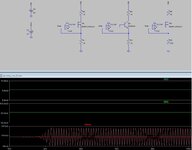sjb741
Junior Member level 2
In AoE - The x-chapters, fig 4x.124 shows a way to cancel the error due to non-zero base current. The circuit sinks 100mA.
When would a designer choose a BJT over a MOSFET in this circuit, given the MOSFET has such a small gate current requirement - for better frequency response?
<EDIT> I simulated this and to my surprise the MOSFET version oscillated but the BJT variant behaved.
At 10mA though, the MOSFET version is fine.
I think the MOSFET used is not too crazy, I tried to chose a 'not too large' gate charge and fairly small Rds.
When would a designer choose a BJT over a MOSFET in this circuit, given the MOSFET has such a small gate current requirement - for better frequency response?
<EDIT> I simulated this and to my surprise the MOSFET version oscillated but the BJT variant behaved.
At 10mA though, the MOSFET version is fine.
I think the MOSFET used is not too crazy, I tried to chose a 'not too large' gate charge and fairly small Rds.
Attachments
Last edited:
